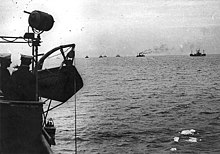
The convoy—a group of merchantmen or troopships traveling together with a naval escort—was revived during World War I (1914–18), after having been discarded at the start of the Age of Steam. Although convoys were used by the Royal Navy in 1914 to escort troopships from the Dominions, and in 1915 by both it and the French Navy to cover their own troop movements for overseas service, they were not systematically employed by any belligerent navy until 1916. The Royal Navy was the major user and developer of the modern convoy system,[a] and regular transoceanic convoying began in June 1917. They made heavy use of aircraft for escorts, especially in coastal waters, an obvious departure from the convoy practices of the Age of Sail.
As historian Paul E. Fontenoy put it, "[t]he convoy system defeated the German submarine campaign."[1] From June 1917 on, the Germans were unable to meet their set objective of sinking 600,000 long tons (610,000 t) of enemy shipping per month. In 1918, they were rarely able to sink more than 300,000 long tons (300,000 t). Between May 1917 and the end of the war on 11 November 1918, only 154 of 16,539 vessels convoyed across the Atlantic had been sunk, of which 16 were lost through the natural perils of sea travel and a further 36 because they were stragglers.[1]
Cite error: There are <ref group=lower-alpha> tags or {{efn}} templates on this page, but the references will not show without a {{reflist|group=lower-alpha}} template or {{notelist}} template (see the help page).
- ^ a b Paul E. Fontenoy, "Convoy System", The Encyclopedia of World War I: A Political, Social and Military History, Volume 1, Spencer C. Tucker, ed. (Santa Barbara: ABC-CLIO, 2005), 312–14.
© MMXXIII Rich X Search. We shall prevail. All rights reserved. Rich X Search
